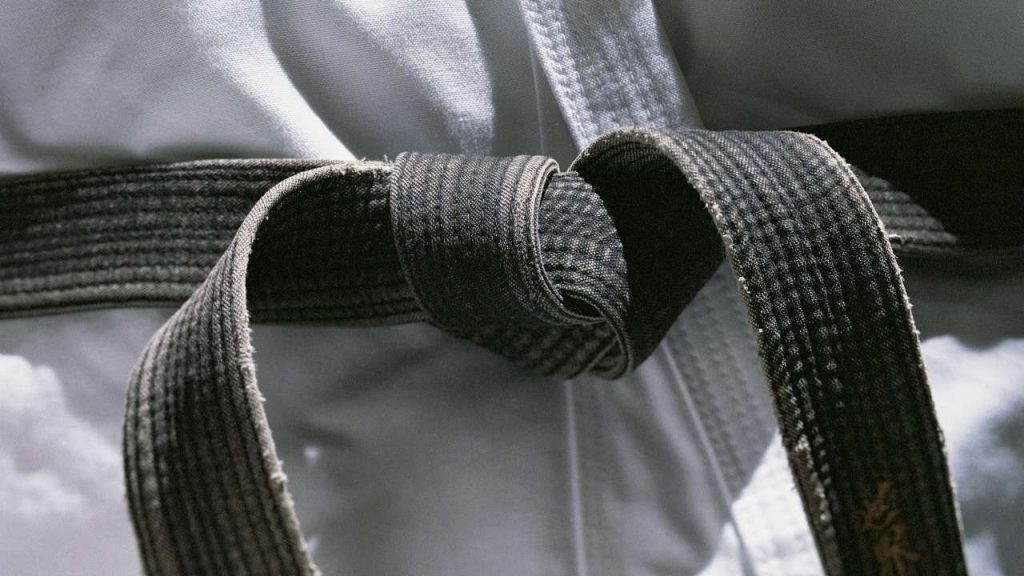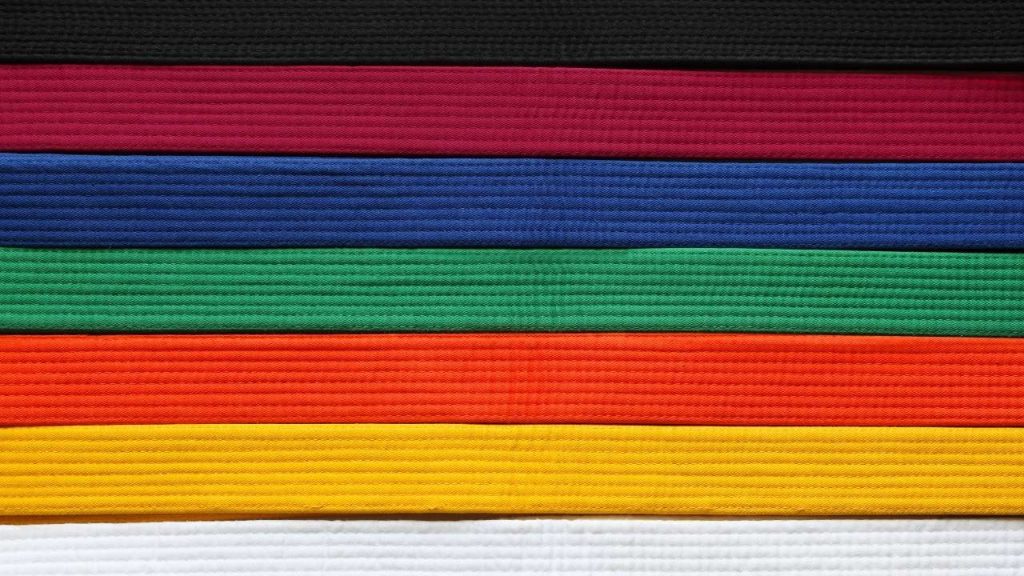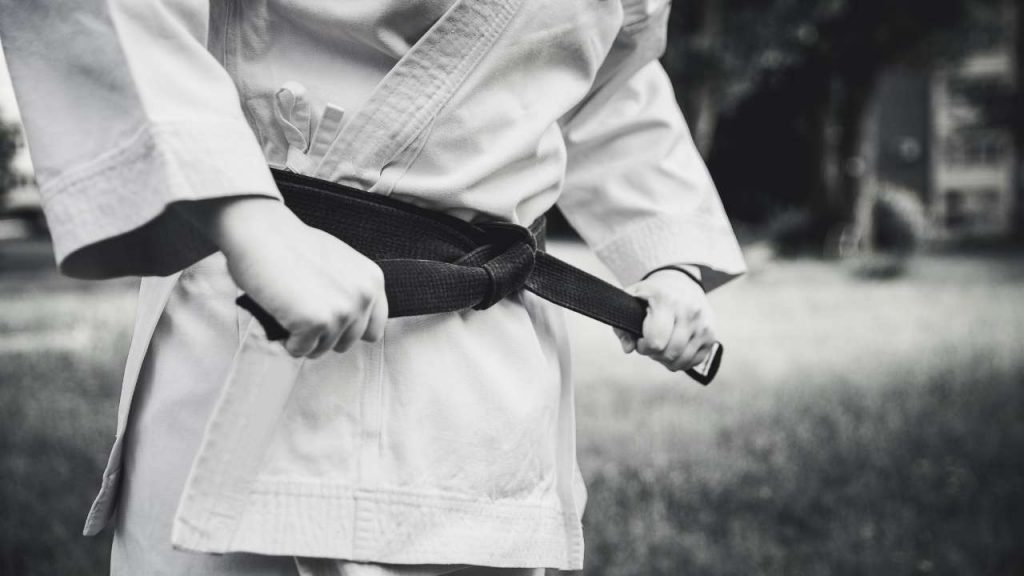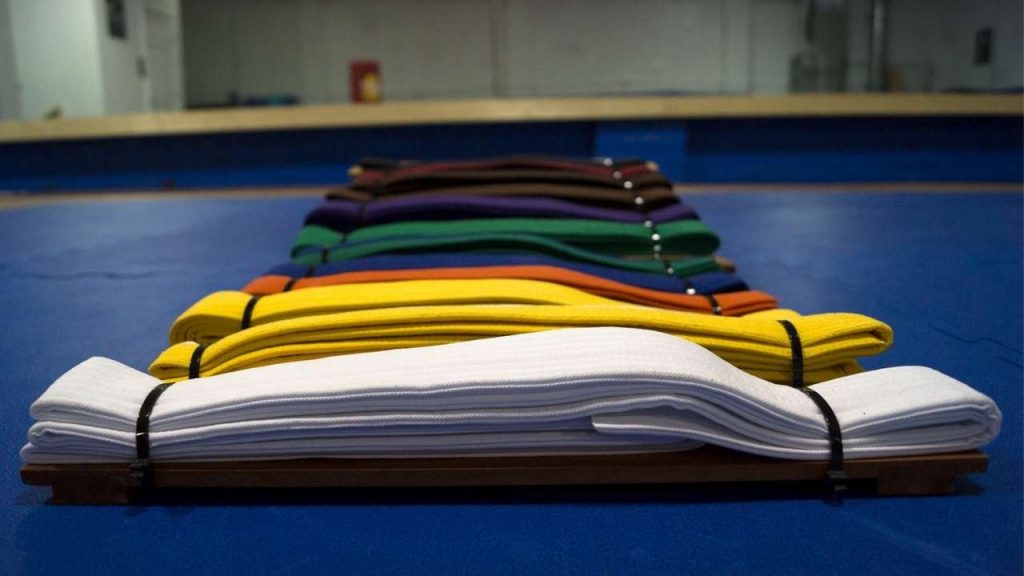Have you ever wondered about all those different colored belts in a Karate class?
The visual cue about a student’s progress is handy. Plus, it provides a source of pride and a sense of accomplishment for Karate students as they move through the ranks and are awarded new colors.
But where did the idea of colored Karate belt levels come from? What is the correct Karate belt order and what is the meaning behind them all? Let’s find out!
Table of Contents
How Many Belts in Karate?
There are 9 belt colors in Karate: white, yellow, orange, green, blue, purple, red, brown, and black. Though most people are only familiar with the two most common belt colors, there may also be more than one level of the same belt color in some karate belt ranking systems.
As the lowest belt in Karate, the white belt is where everyone starts. The largest cohort of students have worn this belt and many people never make it past this point.
The highest belt in Karate, and thus the most coveted, is the black belt. Only about 3-5% of people who started training in Karate will complete their journey to earning a black belt.
Earning a black belt in Karate is a prestigious honor. It takes years to earn your black belt. Most people don’t realize the hours of sweat, tears, and even a little blood that go into earning this prize.
But when you receive your black belt…you’ll know. And the end of pride and accomplishment is profound.
Of course, you’ll also know that you’ve only just begun. Earning a black belt isn’t the end of the road in Karate, it is the beginning of a lifelong journey.

The Origins of the Karate Belt
It might surprise you to know that the whole idea of using different colored belts to denote a student’s rank isn’t that old. Though used in many types of martial arts, the belt ranking system is just a little older than Karate itself.
(If you’re now wondering how young Karate is, check out this post to learn more about Karate’s origins. Spoiler: Karate is technically less than 100 years old!)
The Legend of the Karate Belt’s Origin
There is a legend that you may have already heard about the origins of the Karate belt.
It is said that students were given a white belt when they began their training. Over the years, the belt would become stained and dirty with sweat, dirt, and blood. Students were told never to wash their belts. Superstition said that in doing so, they would “wash off” their experience.
Once the belt turned black, the student was considered a true martial artist.
The legend makes the belts sound both awesome and ominous. Of course, the real story is a little more practical.
The Real History of Karate Belts
For centuries in Okinawa, the birthplace of Karate, martial artists practiced in secret. Wearing a colored belt, or any symbol of their progress or involvement in martial arts, was a dangerous idea.
The idea of a colored belt system actually began with Jigoro Kano, the founder of Judo, in the late 1880s. Before that, students were awarded certificates only as they progressed through the ranks.
Jigoro Kano got the idea from Japanese swimmers who wore a black ribbon around their waist to symbolize their more advanced status. He started giving out belts in his Judo school. White was for beginners, black was for teachers and advanced students.
From Judo, the system migrated to Karate, Tae Kwon Do, and other martial arts styles.
In the early 1900s, a few more colors were added to the system. And it wasn’t until about the 1930s or 40s that the full-color Karate belt system was designed.
Karate Belt Colors
There is no one-size-fits-all ranking system for the Karate belt colors. Different styles of Karate (and sometimes schools within the same style) use different belt systems. The colors of the belt are typically the same, but the colors go in different order and some systems drop a color or two.
Sometimes stripes are added to show progression within a rank before graduating to the next rank. For example, you may remain a white belt for several months as you begin training. However, as your skills develop you’ll earn 1, 2, or even 3, stripes on your belt before graduating to the next color.
Shotokan Karate belt ranks go in this order: white, yellow, orange, green, purple, brown, and black. There are two levels of purple and three levels of brown belt in this system.
Other common color orders include:
- White, yellow, orange, green, blue, purple, red, brown, and black
- White, red, yellow, orange, green, blue, purple, brown, and black
- White, yellow, green, orange, red, blue, purple, brown, and black
The notion of the same white belt turning to black as a symbol of a student’s progress is mythical. However, the idea of the colors progressing from lighter to darker was done for a practical reason.
The colored belt levels in Karate came into more widespread use during and after World War II. At that time, life was hard and money was scarce. Instead of awarding students a new belt for each rank, the same belt was dyed a darker color to conserve resources.

Karate Belt Order
So, how did they pick the Karate belt colors? What does each color mean?
Did a bunch of Karate masters get together one day and toss their favorite colors into a hat, drawing them out until they had enough colors?
Nope.
Like everything else in Karate, there is thought and intention behind the colors chosen. They represent the life cycle of a plant from its humble beginnings to its seeming end.
Here’s how it goes.
1. White Belt
The first belt in Karate, of course, is the white belt. It represents the beginning. As the little plant bursts through the soil, it is greeted by the bright, white light of day.
2. Yellow Belt
As the plant adjusts to the light, it deepens into the golden hue of sunlight. The student is being warmed and stretched in the pursuit of their goals.
3. Orange Belt
As the sun grows hot, life becomes more difficult for the little plant. In the same vein, training becomes more difficult for the student.
4. Green Belt
The little plant has survived the hot sun and is now sending forth new growth. Green leaves and shoots are spreading out from the plant. The student is growing and becoming more proficient in the basics.
5. Blue Belt
The plant is continuing to grow and stretch up toward the bright blue sky. The student’s knowledge is expanding and growing.
6. Purple Belt
The day is drawing to an end, the blue sky darkens to purple. The student’s knowledge is deepening and becoming more profound.
7. Red Belt
The final rays of the sun are red and hot on the blossoming plant. Training is intense but the student has come so far.
Red is also a symbol of danger. The student is becoming proficient enough that they are a danger to their enemies.
8. Brown Belt
The darkness is intensifying and the plant humbly bows its head back towards the soil from which it came. The seed is maturing and ripening as the harvest nears. The student is beginning to reap the rewards of all their toil and training.
9. Black Belt
Darkness falls and the plant dies. But in its place, there is a new beginning. The student has learned so much, including that there is so much more to learn. The first stage of their martial arts journey is complete, but the journey has just barely begun.
Black Belt Degrees in Karate
The journey doesn’t stop once you earn a black belt. There are 10 degrees of black belt, each requiring years of intense training.
For example, in 2011, 98-year-old Keiko Fukuda became the first woman to earn a 10th-degree black belt in Judo. This honor is held by only a handful of others around the world. Needless to say, you must dedicate your life to training and teaching martial arts to ever reach this level.

Karate Belt Order in Different Karate Styles
Shotokan Karate Belt Order
Shotokan Karate follows a dedicated belt system to rank a student. The karate belt system uses a variety of colored belts to determine an individual’s skill level. With each passing level, the colour of the belt gets darker. Many also believe in the theory of the white belt becoming dirty over time and turning black, representing a black belt, the best rank.
Mentioned below is the belt ranking system in Shotokan Karate:
| Rank | Belt Color | Kata Required |
|---|---|---|
| 9th Kyu | White | Heian Shodan |
| 8th Kyu | Yellow | Heian Nidan |
| 7th Kyu | Orange | Heian Sandan |
| 6th Kyu | Green | Heian Yondan |
| 5th Kyu | Purple | Heian Godan |
| 4th Kyu | Purple and White | Tekki Shodan |
| 3rd Kyu | Brown | Bassai Dai |
| 2nd Kyu | Brown and White | Bassai Dai |
| 1st Kyu | Brown and White | Bassai DaiKanku DaiJionOr Empi |
| Shodan 1st Dan | Black | All Kata’s |
Kyokushin Karate Belt Order
The students of the Kyokushin discipline are awarded belts once they’ve demonstrated techniques for the appropriate belt levels. These can be mastering certain kicks, strikes, or katas. The schools have become splintered over the years and the belt rankings may vary. Ask your instructor for the belt rankings at your school. The following list contains the commonly used belt ranking system:
| Level | Belt |
|---|---|
| Mukyu | White Belt |
| 10th Kyu | Orange Belt |
| 9th Kyu | Orange Belt with Blue Stripe |
| 8th Kyu | Blue Belt |
| 7th Kyu | Blue Belt with Green stripe |
| 6th Kyu | Yellow Belt |
| 5th Kyu | Yellow Belt with Orange Stripe |
| 4th Kyu | Green Belt |
| 3rd Kyu | Green Belt with Brown Stripe |
| 2nd Kyu | Brown Belt |
| 1st Kyu | Brown Belt with black stripe |
Kyokushin Black Belt Order:
| Name | Belt | Number of Gold Stripes |
|---|---|---|
| Shodan | 1st Degree (Dan) Black | 1 |
| Nidan | 2nd Degree (Dan) Black | 2 |
| Sandan | 3rd Degree (Dan) Black | 3 |
| Yondan | 4th Degree (Dan) Black | 4 |
| Godan | 5th Degree (Dan) Black | 5 |
| Rokudan | 6th Degree (Dan) Black | 6 |
| Shichidan | 7th Degree (Dan) Black | 7 |
| Hachidan | 8th Degree (Dan) Black | 8 |
| Kyūdan | 9th Degree (Dan) Black | 9 |
| Jūdan | 10th Degree (Dan) Black | 10 |
Shorin Ryu Karate Belt Order
Once you start training Shorin Ryu, your desire to get better and avail higher ranks will definitely increase. To assess your growth, there’s a ranking system based on belt colors.
Here are the belt ranks for Shorin Ryu Karate:
| Color | Order |
|---|---|
| White Belt | Beginner level |
| Yellow Stripe Belt | 8th kyu |
| Yellow Belt | 7th kyu |
| Orange Belt | 6th kyu |
| Green Belt | 5th kyu |
| Purple Belt | 4th kyu |
| Brown Belt | 3th kyu |
| Brown Belt | 2th kyu |
| Brown Belt | 1th kyu |
As soon as you reach the first kyu level, the next goal is to get the black belt. On average, it takes 4 to 6 years for an individual to reach that level. But that isn’t the ultimate goal, though. Black belts are further categorized into Dan’s grades.
Here’s a Dan grades system:
| Color | Order | Minimum time to achieve |
|---|---|---|
| Black Belt | 1st Dan | 4-6 years |
| Black Belt | 2st Dan | 2 years after 1st Dan |
| Black Belt | 3st Dan | 3 years after 2st Dan |
| Black Belt | 4st Dan | 4 years after 3st Dan |
| Black Belt | 5st Dan | 5 years after 4st Dan |
| Black Belt | 6st Dan | No such estimated time. |
| Black Belt | 7st Dan | Same goes for it. |
| Black Belt | 8st Dan | This stage is the toughest and takes even 5-10 years. |
Wado Ryu Karate Belt Order
The belt ranking system for Wado Ryu Karate is as follows:
| Level | Belt Color | Kata |
|---|---|---|
| Hachikyu – 8th Kyu | Yellow Belt | First grade. Kihon, no Kata or basic Kata |
| Sichikyu -7th Kyu | Orange Belt | To earn the belt the kata is Pinan Nidan |
| Rokyu – 6th Kyu | Green Belt | The Kata for this rank is Pinan Shodan, Pinan Shandan |
| Gokyu – 5th Kyu | Blue Belt | Pinan Shodan, Yondan |
| Yonkyu – 4th Kyu | Purple Belt | Students have to pass this Karate test Pinan Godan, Yodan for this rank. |
| Sankyu -3rd Kyu | Brown Belt- 1 stripe | Pinan Godan |
| Ni Kyu-2nd Kyu | Brown White Belt- 2 stripes | Kushanku |
| Ik Kyu-1st Kyu | Brown Black Belt-3 stripes | Naihanchi |
After you have achieved these levels, students step further into Black ‘Dan’ levels. Black belt has 10 different levels starting from Shodan, Nidan, Sandan, Yondan, Godan, Rokudan, Nanadan, Hachidan, Kudan, to lastly Judan.
Goju Ryu Karate Belt Order
The belt order followed for Goju-ryu Karate is mentioned in the table below:
| Belt Color | Rank |
|---|---|
| White | Ungraded |
| White with tab | 10th kyu |
| Blue | 9th kyu |
| Blue with tab | 8th kyu |
| Yellow | 7th kyu |
| Yellow with tab | 6th kyu |
| Green | 5th kyu |
| Green with tab | 4th kyu |
| Brown | 3rd kyu |
| Brown with tab | 2nd kyu |
| Brown with 2 tabs | 1st kyu |
Uechi Ryu Karate Belt Order
The belt ranking of Uechi Ryu Karate:
| Rank | Belt | Requirements |
|---|---|---|
| Jukyu -10th Kyu | White Belt | |
| Kyukyu – 9th Kyu | White Belt With Green Stripe | Sanchin, Exercises |
| Hachikyu – 8th Kyu | White Belt With Two Green Stripe | Kanshiwa, Sanchin, Exercises |
| Sichikyu -7th Kyu | White Belt With Three Green Stripe | Sanchin, Exercises + Kanshiwa Bunkai |
| Rokyu – 6th Kyu | White Belt With Green Bar | Kanshu, Kotikitai, Kyu Kumite And All Above |
| Gokyu – 5th Kyu | Green Belt | Sparring And All Above |
| Yonkyu – 4th Kyu | Green Belt With Brown Bar | Seichin And All Above |
| Sankyu -3rd Kyu | Brown Belt With Black Stripe | Strong Sparring And All Above |
| Nikyu – 2nd Kyu | Brown Belt With Two Black Stripes | Seisan, Seisan Bunkai And All Above |
| Ikkyu – 1st Kyu | Brown Belt With Three Black Stripes | Kenyuikai Kumite And Above |
Shuri Ryu Karate Belt Order
Like most karate ranking systems, Shuri Ryū also has the belt system. Trias himself laid out the rules of the ranking system in “The Pinnacle of Karate”.
The ranking system is as follows:
| Order | Color of the Belt | Time |
|---|---|---|
| 7th Kyu | White | 3 weeks |
| 6th Kyu | Yellow | 2 months |
| 5th Kyu | Green | 6 months |
| 4th Kyu | Blue | 15 months |
| 3rd Kyu | Purple | 2 years |
| 1st-2nd Kyu | Brown | 2.5 years |
| 1st-10th Kyu | Black | 4 years |
Shito Ryu Karate Belt Order
The ranking of belts starts from 9th Kyu, which means the beginner level to Shohdan/1st dan. For better insight, we have mentioned the belt ranking system of Shito-Ryu in the table below.
| Grade | Colour Of The Belt | Minimum Training + Karata To be Performed |
|---|---|---|
| 9th Kyo | white + yellow tip | 3 weeks (taikyoku Jodan) |
| 8th Kyo | Yellow | 2 months ( taikyoku Chudan) |
| 7th Kyo | Orange | 4 months (taikyoku Gedan) |
| 6th Kyo | Green | 9 months (Gekisai Ichi) |
| 5th Kyo | Blue | 15 months (Gekisai Ni) |
| 4th Kyo | Purple | 2 years (Saifa) |
| 3rd Kyo | Brown | 2.5 years (Gekisai Ichi + Ni/Saifa) |
| 2nd Kyo | Brown + Black tip | 3 years (Gekisai Ichi + Ni/Saifa) |
| 1st Kyo | brown + 2 black tip | 3.5 years(Gekisai Ichi + Ni/Saifa) |
| Shodan | Black | 4 years ( min. Age 13 years) (Sanchin) |
Chito Ryu Karate Belt Order
Chito Ryu Karate has a belt system that runs from white to black with multiple levels in between. Here are details on how this system works:
| Rank | Belt | Kata | Kumite | Time |
| 13th Kyu | White | 4 weeks | ||
| 12th Kyu | Yellow | Kihon dosa ichi | 6 weeks | |
| 11th Kyu | Orange + White tip | Kihon dosa ichi | 2 months | |
| 10th Kyu | Orange | Kihon dosa ichi | 3 months | |
| 9th Kyu | Green + White tip | Kihon dosa ichi | 5 months | |
| 8th Kyu | Green | Kihon dosa ichi | Jiyu kumite | 8 months |
| 7th Kyu | Blue + White tip | Kihon dosa ni | Jiyu kumite | 9 months |
| 6th Kyu | Blue | Seiken no migi hidariKihon kata ichiKihon dosa san | Jiyu kumite | 1 year |
| 5th Kyu | Purple + White tip | Zenshin kotai Kihon kata ni Kihon dosa yon | Jiyu kumite | 1.5 years |
| 4th Kyu | Purple | Shiho wariKihon kata sanShiho hai | Jiyu kumite | 2 years |
| 3rd Kyu | Brown + White tip | Seisan | Jiyu kumite | 2.5 years |
| 2nd Kyu | Brown | Niseishi | Jiyu kumite | 3 years |
| 1st Kyu | Brown + Black tip | Bassai | Jiyu kumite | 4 years |
| Dan Ranks | Black | Chinto | Shiai | 5 years |
After the black belt, there are still some grades that can be promoted, they are Shodan, Nidan, Sandan, Yondan, Godan, Rokudan, Nanadan, Hachidan, and Kyudan.
Your Martial Arts Journey
If you haven’t begun your own journey yet, you’ll start with everyone else — with a white belt. Should you undertake this training, you’ll be in for a life-changing adventure.
Looking for tips and advice along the way? Check out more about effective karate techniques.


